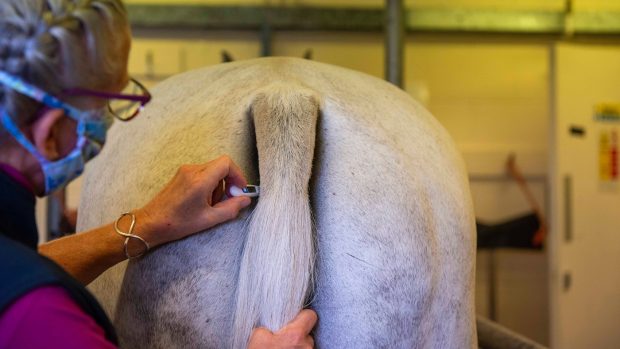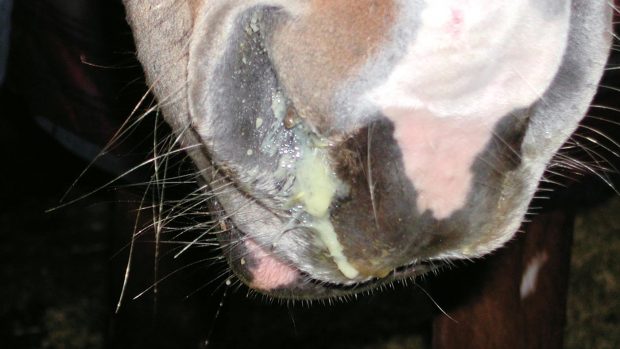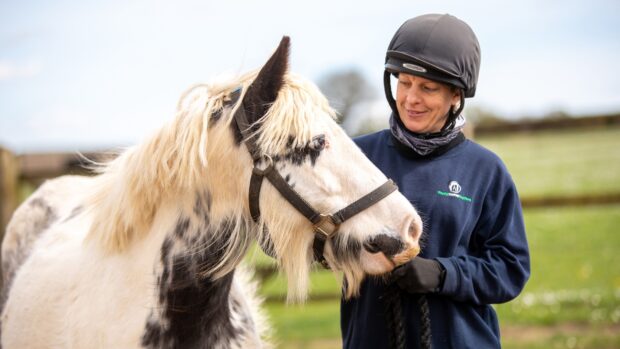An owner who was at her “wits’ end” as she dealt with a three-month strangles outbreak hopes to raise more awareness of the support available – but said stigma surrounding the disease still exists.
Kent-based Angie Driver moved to a new yard on 21 December last year with her 20-year-old part-bred Irish draught mare Annie and seven-year-old cob Cody. Two days later Angie collected a seven-month-old miniature Shetland, Bunty, whom she had viewed the previous month.
“The day after Bunty arrived I noted she had a sticky eye and a wound above it so I got the vet out,” she told H&H.
“The vet thought the wound was an abscess caused by a foreign object such as a thorn. He took a swab to check the bacteria – then on Christmas Day a second abscess appeared.”
Angie said she did not suspect strangles at the time but as a precaution adopted biosecurity measures and warned other liveries not to touch Bunty.
“On 30 December another abscess appeared, under her jaw, and on New Year’s Eve we had a positive strangles diagnosis,” she said.

“Bunty had been kept in since the first abscess appeared, but on the first day of her arrival she had been able to touch Annie and Cody over the fence so I was worried they could have been infected.”
Angie said Bunty’s condition improved, but then Cody and Annie started showing signs of strangles. Cody developed nasal discharge on 6 January, then “bounced back” and on 18 January Annie developed nasal discharge and swollen glands – and abscesses later “erupted”.
“A few weeks later Annie developed choke but it was different from what I’ve seen before. The vet came and lanced her throat and about a pint of pus came out – it went everywhere,” she said.
“On 7 February Annie still wasn’t right and she was admitted to the vet hospital and Bunty went in too after she developed four further abscesses.”
Angie said Bunty’s abscesses were lanced, and Annie’s throat scoped, which found nerve damage from the abscesses was causing food and pus to build up, making it difficult for her to swallow.
“I was at my wits’ end – Annie is my horse of a lifetime and I couldn’t face losing her,” said Angie.
After four days on antibiotics, Annie tested clear of strangles on 29 February. Angie said she was keen to make sure none of the horses had become a strangles carrier so she had Cody scoped on 5 March.
Vets found he had a large chondroid, which is formed of a build-up of pus in a horse’s guttural pouch. These can carry bacteria, which can cause a strangles outbreak – even though the horse may appear to be well. A vet can remove chondroids and flush the guttural pouch, before re-testing to check the horse is infection-free.
“He appeared completely normal but he would have been a carrier and we wouldn’t have known,” she said. “We will repeat the procedure in four weeks, but Bunty is too small to have this done so she requires three-weekly swabs to test her.”
Owing to the lockdown restrictions Angie has had to wait for the follow-up procedures but hopes now that vets are carrying out more routine work, these can take place soon.
Angie said she has received lots of positive comments and messages.
“When it first happened I told everyone on the yard and we went into lockdown straight away, but I didn’t put it on social media because I didn’t want people to panic – but then a post appeared on a Facebook group stating there was strangles in the area,” said Angie. “Someone tagged me in the post so I wrote a lengthy reply and explained what had been happening.
“People have been so lovely. Some have messaged me saying I was brave to speak out, which indicates how much stigma is still out there – people would speak out more if there wasn’t that stigma.There is ignorance around strangles and people can panic when there is an outbreak.”
Article continued below…

Riding school’s future in jeopardy after ‘catastrophic’ strangles outbreak
‘Potentially we may not open as a riding school if we have to sell the horses and ponies to pay

New ‘vital’ strangles tool available to owners and vets
Dr Richard Newton said the website provides ‘comprehensive insights’ about the disease that have never been available before

Subscribe to Horse & Hound magazine today – and enjoy unlimited website access all year round
Angie hopes to raise more awareness of strangles and support the Redwings Stamp Out Strangles campaign and awareness week (4 to 10 May).
“I knew a bit about strangles and infectious disease like equine flu previously, but I’m hoping to help others in my area and spread the message about the support available through the Redwings campaign and the awareness week,” she said.
“I’ve learnt a lot and I’m so happy I was able to contain it to my own horses at the yard using biosecurity practices. I was so new to the yard and didn’t know anyone but everyone was really supportive.”
We continue to publish Horse & Hound magazine weekly during the coronavirus pandemic, as well as keeping horseandhound.co.uk up to date with all the breaking news, features and more. Click here for info about magazine subscriptions (six issues for £6) and access to our premium H&H Plus content online.




